GREEN LIVING

WHAT'S IN YOUR WATER?
A look at Arizona's water quality standards
Beneath the Surface
The future of Arizona's lakes
The World of Marine
Citizen Science
Biosphere Expeditions celebrates 25 years of wildlife conservation



A look at Arizona's water quality standards
Beneath the Surface
The future of Arizona's lakes
The World of Marine
Citizen Science
Biosphere Expeditions celebrates 25 years of wildlife conservation


Utilizing natural elements to balance water.

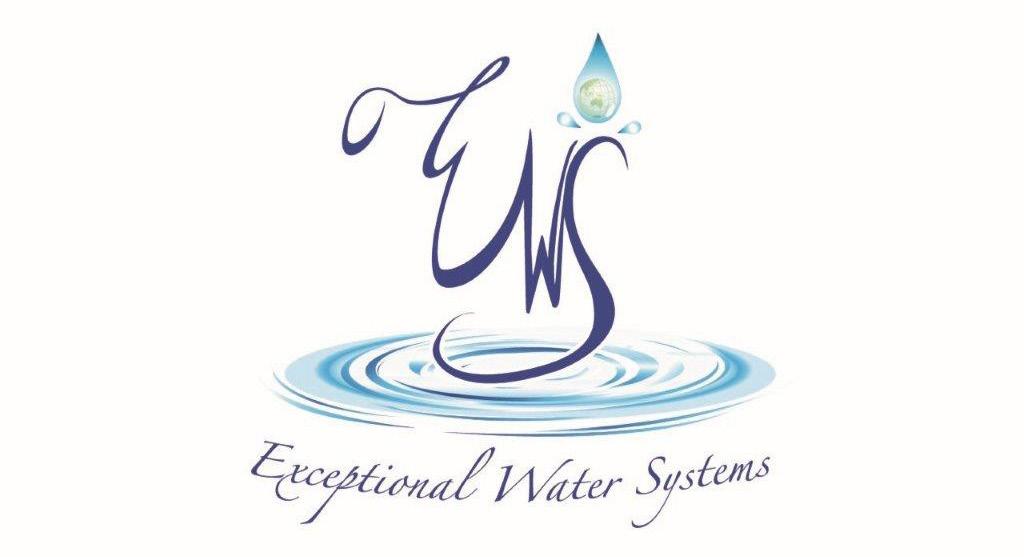


BY MICHAEL GEYER
For many years, designers and contractors have been creating stunning pools using beautiful stones with intricate designs. These pools captivate us with their elegance and the way water moves so gracefully within them. But beyond their beauty, there's something even more essential – the water itself.
At Exceptional Water Systems, we believe that the water in these artistic creations holds the key to natural healing. Our Highly Dissolved Oxygenated (HDO) water is exceptionally healthy. When properly treated, it can even nourish your plants, making them grow 3-4 times larger and faster, similar to the benefits of fresh rainfall.
The Problem with Traditional Pool Water
Traditional pools are often filled with numerous chemicals like chlorine, salt, acid, flocculants, and other chemicals. While we might enjoy a dip, we often end up with sunburned skin that smells like chlorine. The aftermath includes peeling skin and the need for lotions to heal the damage. This cycle repeats itself, causing discomfort and potential long-term health issues such as swimmer’s lung, hair loss, chlorine allergies, skin problems, and asthma.
The Solution: Exceptional Water Systems
For over a decade Exceptional Water Systems has perfected the HDO system to help deliver the highest water quality for swimming imaginable. Our Aqua Fuzion diffusing system uses pure oxygen and ozone to disinfect, oxidize, and create one of the healthiest swimming environments possible. The HDO
treated water results in an incredibly soft, crystalclear, chlorine-free, natural swimming experience. Oxygen, widely used in medical settings for its healing properties, enhances the water quality and provides a much gentler experience compared to chemically treated pools. After your first experience swimming in HDO water, it is highly likely you will never want to swim in a chlorinated pool again!
Natural and Safe Water Treatment
To balance the water’s pH, we use carbon dioxide, a natural and abundant element. Unlike traditional acids, carbon dioxide (in HDO format) is highly efficient at reducing the pH quickly and leaves no harmful byproducts. It also maintains the water’s alkalinity, making it a safer and healthier option.
A Healthier Swimming Experience
We understand the frustrations of those who suffer from health issues caused by traditional pool water. Exceptional Water Systems is committed to providing a clean, safe, and healthy swimming environment. Experience the difference with our systems and enjoy water that is beneficial for both you and your loved ones.
If you would like to learn more about our systems and how they can help you, please feel free to contact us at www.exwsystems.com or call us at 480-694-4709.
Exceptional Water Systems… continuously thriving to provide Healthy Water for Humanity!

Diner’s Herbaceous Shakshuka + Pita Jungle’s Southwest Gazpacho
in


Dear Readers,
Water. It is, perhaps, the single-most important building block of life — and it’s the focus of this month’s issue. It sustains every living organism on our planet. It provides food for us to eat, hydration to keep us healthy — and it’s critical to ecosystems and socioeconomic development the world over. To be without it would mean certain death for the human race and all other living creatures.
Beyond its obvious life-giving value, for me, water is also a great healer. Playing in the ocean, enjoying the ebb and flow of energy and constant rhythm of nature — or simply marveling at its power and vastness — are among my most favorite activities on Earth.
And while there (sadly) might not be oceanfront property in Arizona, it seems that these days, there’s more to say about water in our state than ever before. As I write this, members of the Navajo Nation, Hopi Tribe, and San Juan Southern Paiute have gathered to hold a water settlement signing ceremony that will (finally) put an end to the water rights debate and provide the tribes with the funding needed for essential water development, delivery projects, and a large distribution pipeline. A notso-fun fact for you: 30% of Navajo Nation families currently live without running water.
Last year, water conservation measures by the City of Scottsdale left the town of Rio Verde high and dry, as it were, when the city ceased its water-hauling operations to the remote area. (In fairness, the city provided a two-year heads up to the residents of Rio Verde when its 2021 Drought Management Plan was finalized). You may remember that Arizona — and much of the Southwest — was set up for an intensely dry 2021, created by a 2020 monsoon season that was the driest on record for Arizona and western New Mexico. An abysmal 2023 monsoon season offset by decent snowmelt has simply left Arizonans hanging on in 2024. The point is, water is a precious resource that, due to climate change, might not be as renewable as we thought.
So, let’s not just chit-chat about it — let’s get to what we can all do to protect it. This issue is full of tips, reports, education, and valuable information that we can all use to do better to conserve our most valuable commodity. Dive in, dear friends — the water’s fine.
Thanks for reading,
Shelby Tuttle Managing Editor

Got a burning question or comment? Reach out at editor@greenlivingmag.com.

Valerie is a certified nutritionist and microbiome specialist based in Los Angeles. Over the last five years, she has had the privilege of helping more than 3,000 clients achieve their health goals, helping them to sleep better, have more energy, reverse chronic health conditions and feel their best. For more on her work, visit www.nutritioncoachvalerie.com.

Angela Fairhurst is a non-fiction television producer and travel journalist whose work has been featured in Matador Network
Southern California Life Magazine, Gio Journal, and on her own site, Jaunt TV — which includes a bevy of exciting videos. She has a knack for writing about luxury hotels and luxury hotel bathrooms, but is well-versed in living green, from the jungles of Costa Rica to wine tasting in the Land Down Under. Follow her on Instagram @jaunttv.
PUBLISHER
MANAGING EDITOR
ONLINE EDITOR
ART DIRECTION & DESIGN
GRAPHIC DESIGNER
COPY EDITOR
STAFF PHOTOGRAPHER
CONTRIBUTORS
Jennifer Burkhart
John Burkhart
Rebecca Davidson
Jeny Davis
Tiffany Candelaria
Anna Dorl
Angela Fairhurst
ADVERTISING SALES
Dorie Morales
Shelby Tuttle
Shelby Tuttle
Sly Panda Design
Melat Alebachew
Colleen Kern
Brett Prince
Rithwik Kalale
Misty Milioto
Valerie Poirier
Laine Seaton
Colleen Kern
Sasha Stortz
Dorie Morales - sales@greenlivingmag.com
George Heussner - george.h@greenlivingmag.com
EVENTS
Danielle Coletto - events@greenlivingmag.com
INTERNS
Yula Armstrong
Katarina Guenther
Kirsten Kennett
CONTACT US AT:
Subscriptions: hello@greenlivingmag.com
Advertising: sales@greenlivingmag.com
Editorial: editor@greenlivingmag.com
Olivia Sanwick Paige Sundelius
480.840.1589 • www.greenlivingmag.com 13845 N Scottsdale Rd, Ste. 201, Scottsdale, AZ 85254


Please recycle this magazine


During monsoon season, it’s vital for Arizonans to learn how to prevent an infestation of these desert dwellers in the home. Heavy monsoon rainfall can flush scorpions out of their ideal hiding places, leading to heightened arachnid activity.

In the U.S., most get just ten paid vacation days a year, treasured as moments to fulfill desires. Yet, why wait all year for those few days? Instead of judging downtime, embrace it as vital for life creation. Explore what recharges you — be it play, solitude, or creativity. Thriving emerges when we follow our rhythms, not rigid schedules.

2024 is Boyce Thompson Arboretum’s 100-year anniversary! If you are looking for a green and sustainable place to visit this summer, make sure to check them out!

Audi has introduced a limitededition electric mountain bike in collaboration with Fantic, enhancing its electric mobility lineup. This highperformance enduro-style eMTB features a lightweight aluminum frame, mixed-wheel sizing, and full suspension with 180mm travel.

Check out our conversation with AZ Wilderness Brewing CEO Jon Buford about local farmers for regenerative agriculture, how AZ Wilderness’s seasonal beers are made with local farmers, and Jon’s new book coming out in September!

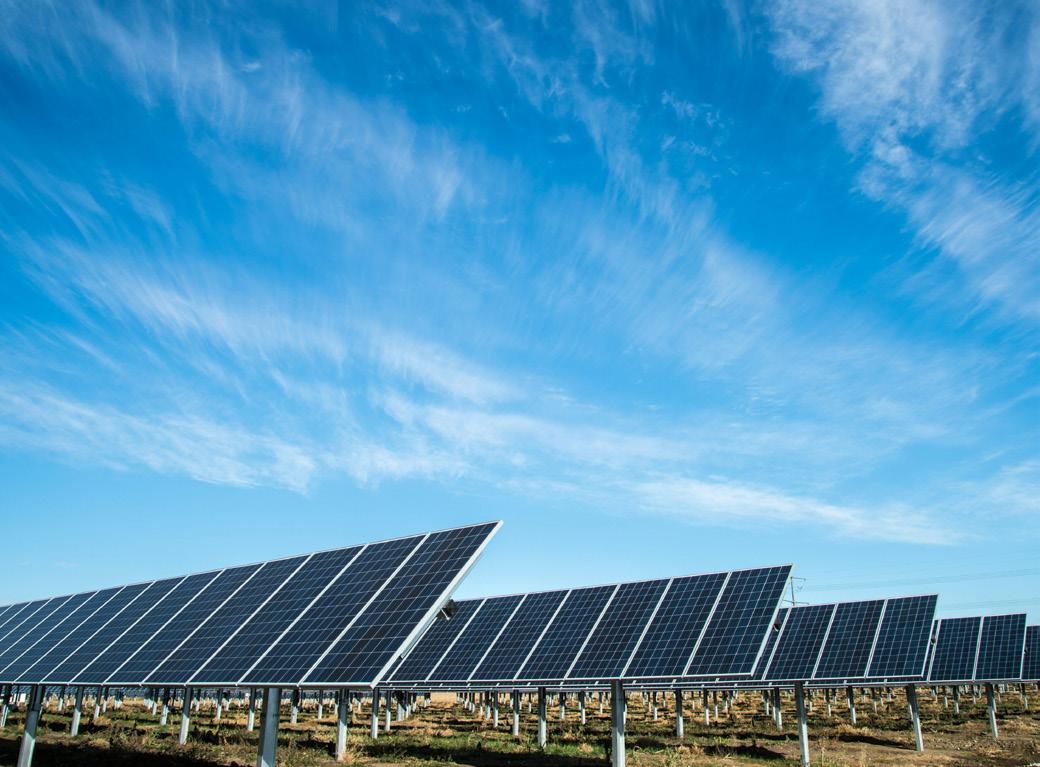
National Grid Renewables has launched the Wild Springs Solar Project in Pennington County, South Dakota, marking the state's largest solar endeavor at 128 MW. Supported by a 114 MW Power Purchase Agreement with Basin Electric, it aims to provide significant economic benefits and clean energy solutions, reducing 190,000 metric tons of CO 2 annually.
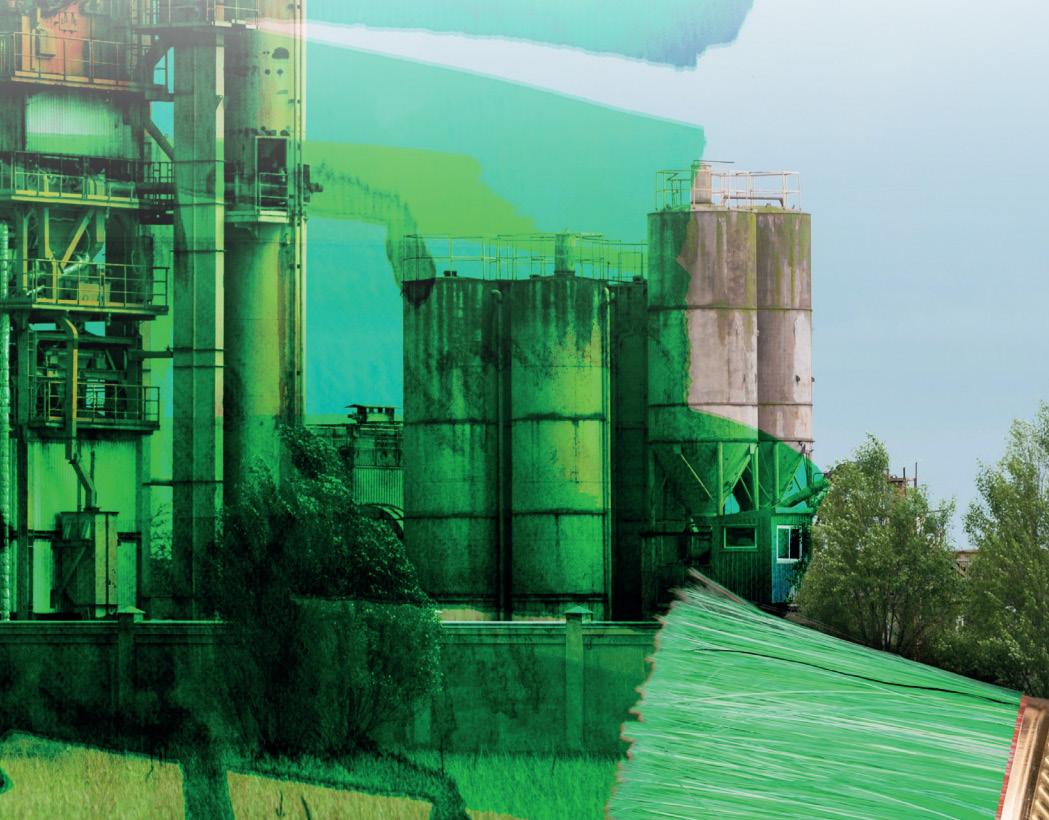
A new report by Planet Tracker highlights a growing pressure on corporations to address climate concerns and review memberships in industry associations that contradict their stated environmental goals.
Pharmaceutical giant Bayer’s efforts are highlighted as good practice, noting the company’s 2023 Industry Association Climate Review which assesses its relationship with 63 associations, in addition to disclosing the methodology used for the evaluation.

On May 22, Blue Zones Project Scottsdale announced that HonorHealth Corporate Office, DC Ranch Village Health Club & Spa, Gainey Ranch Village Health Club & Spa, and ARCHSOL have achieved Blue Zones Project Approved worksite status.

On June 18, the FISH Act was introduced to bolster U.S. fisheries' resilience against climate change impacts. The legislation aims to equip fisheries with tools to adapt to warming oceans, marine heatwaves, and other threats, ensuring sustainable seafood businesses and healthy oceans.

Earthjustice and the Environmental Defense Fund are intervening in a lawsuit brought against the EPA by Denka Performance. Denka seeks to delay compliance with EPA regulations despite links between its operations and high local cancer rates surrounding its chloroprene rubber plant in Louisiana, prompting urgent legal action for community health protection.


July 26th - August 21s


Green Living is thrilled to announce voting for our 2024 "Best of Arizona" awards! Vote to help your favorite sustainable businesses and ecoconscious individuals gain recognition for the difference they make for our planet every day. Winners will be published in the October issue of Green Living and celebrated at our annual event! Voting is


BY ANNA DORL
Water makes the world go-round, giving life to even the smallest living beings on our planet. Without it, life simply wouldn't exist. Living in harmony with the water that surrounds us is essential to keep in mind, whether that means treating our lakes and rivers with respect when enjoying nature or being more mindful of its use at home. Check out these products designed to improve your relationship with good old H20.
You may think you’ve seen just about every reusable and sustainable water bottle that the world has to offer. But the Original Ocean Bottle isn’t just sustainable, it actually funds the collection of 1,000 ocean-bound plastic bottles. These 17-ounce water bottles are constructed from BPAfree plastic, silicone, and recycled materials, including stainless steel. Each one is dishwasher safe and capable of maintaining temperatures of both cold and hot drinks for longer than you’d think possible. www.oceanbottle.co
Let’s face it — sunscreen is a necessity and is even more important when the UV index rises. Sensitive Mineral Sunscreen from Blue Lizard Australian Sunscreen provides users with reef-friendly SPF 50+ that includes zinc oxide. By using a mineral sunscreen instead of one containing oxybenzone and octinoxate, you’re helping to save coral reefs from destruction while saving your skin from a sunburn. This sunscreen’s Smart Cap technology changes to a purple hue when it senses dangerous UVA and UVB rays, and its formula’s intentional ingredients were chosen alongside dermatologists and are intended especially for sensitive skin. www.bluelizardsunscreen.com

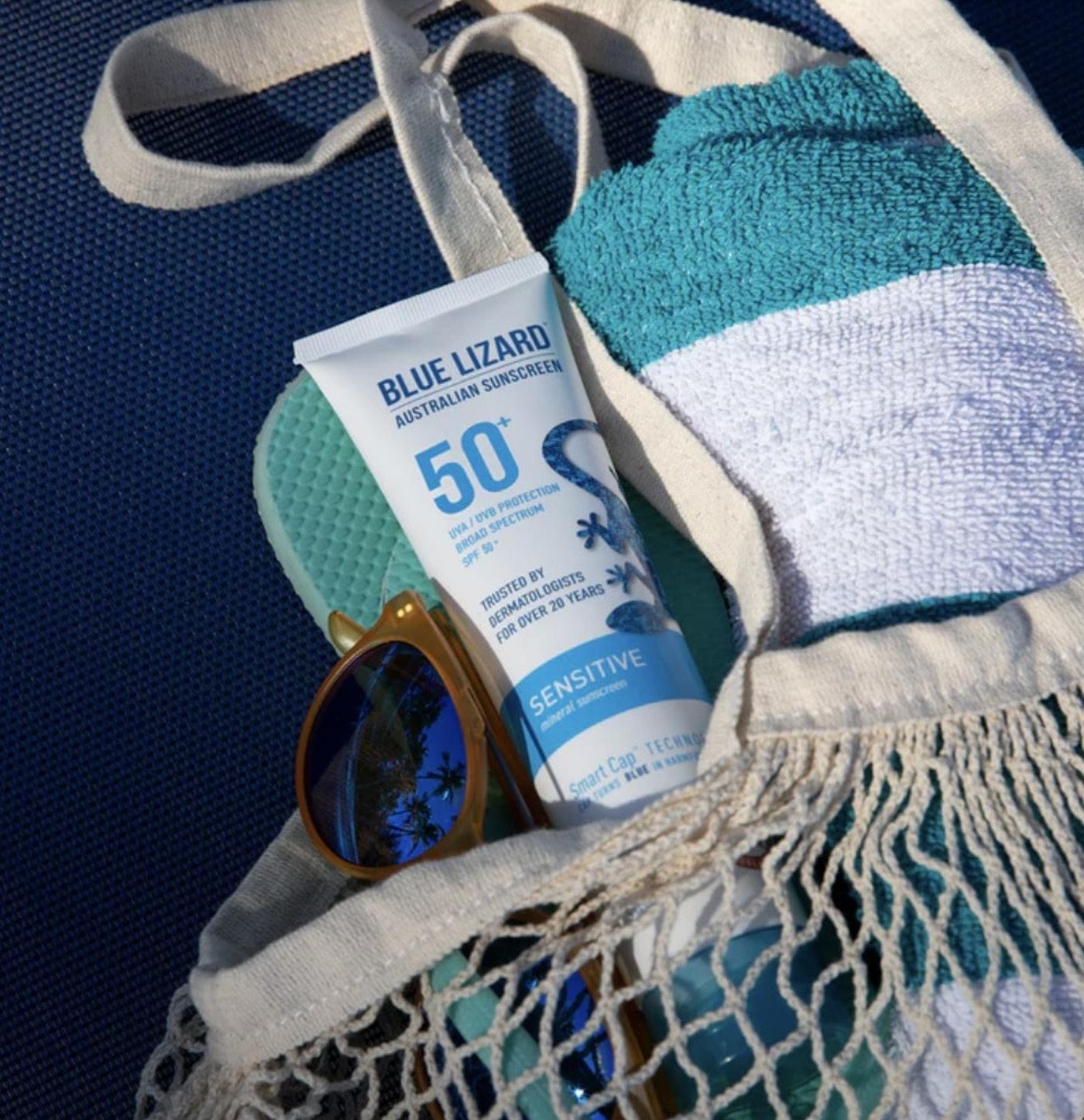



Many people recognize the name LifeStraw through the company’s original straw filters, but the brand’s expansion provides effective filtering technology for more than one drinker at a time. If you’re looking for a large-capacity water filtration device perfect for the fridge, look no further than the LifeStraw Home 7-Cup Water Pitcher Filter. As a BPAfree hydration station, it includes two filters: a carbon filter and a membrane microfilter. When water trickles through the filter, impurities are extracted to create both a better taste and a safer glass of H2 0. These pitchers are available in seven colors, and a 10-cup option is available, as well. www.lifestraw.com
Products made from recycled, reclaimed, and repurposed materials are becoming more and more mainstream. Who knew helping the planet could become (and remain) trendy? The unique identities of these products bring a fresh sense of sustainability into everyday consumerism, and Nixon’s Siren watch is a great example. As a company, Nixon prioritizes the usage of recycled materials, especially ocean plastics. Nixon uses #Tide recycled plastic waste to create the super-durable case material, transforming trash into a digital watch that meets both form and function. It’s available in six color options with a silicone band and a water rating to 100 meters. www.nixon.com
Being able to maximize water’s hydrating effect on our bodies can be one of the best things we can do for ourselves. Plexus Hydrate powder drink mix is packed full of ingredients that boost hydration to new levels with coconut water powder (a natural hydration remedy), potassium (to provide optimal function to your muscles and nerves), and magnesium (to help your body hold onto the potassium it needs). Packets come in Blueberry Acai or Lemon Lime flavors. www.plexusworldwide.com

The team at Green Living lost a beautiful and dear friend last month. David M. Brown, a long-time supporter of and writer for the magazine, passed away on July 15, 2024 at the age of 71. Apart from being one of our most frequent and valued contributors, David was a gardening enthusiast, car aficionado, lover of animals, connoisseur of good food, and even more so of great wine. Above all, his greatest love was that of his family — his kids, Shaun and Sheena, and his dogs, Curry and Zoey.
His love for learning about different cultures was often illustrated in his work, which spanned more than three decades and appeared locally in outlets like The Arizona Republic, Phoenix Magazine, and Phoenix Home & Garden, along with nationally recognized outlets like The Robb Report and Architectural Review. During his prestigious career, David interviewed the likes of Joan Baez, Jay Leno, Jacques Pépin, President Clinton, Sen. John McCain, and a host of other famous personalities.
David was not just a contributor to Green Living, he was a friend — a kind and caring soul whose loss will not only be felt indefinitely within these pages, but in our hearts, as well.





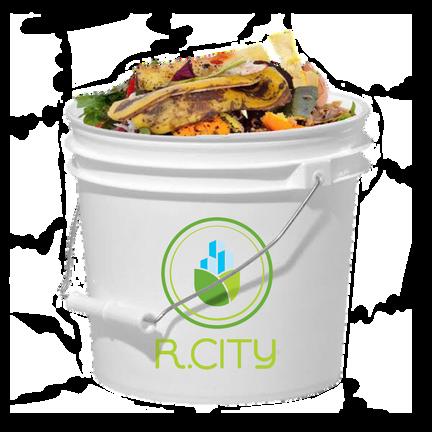







Seattle’s Ridwell is on a mission to transform the cycle of waste
BY ANGELA FAIRHURST
EEach year, the average person sends a staggering 912 pounds of waste to landfills. This sobering statistic underscores the urgent need for innovative solutions to tackle the global waste crisis. Enter Ridwell, a company on a mission to revolutionize the way we handle our trash. With a network of over 200 local and regional partners, Ridwell is spearheading efforts to recycle and reuse items that would otherwise end up in landfills.
Ridwell's journey began with a simple idea and a commitment to making a difference. Ryan Metzger, the CEO and co-founder of Ridwell, realized the challenges of safely disposing of batteries. This inspired him to not only find a solution for his own household but to encourage his neighbors to join in. Together with his six-year-old son Owen, Ryan started a small recycling carpool of sorts, collecting batteries and a variety of other items from their community.
Their initiative quickly gained momentum. From
light bulbs and electronics to clothes hangers and plastic bags, they sought to find new homes for items that would otherwise end up in the trash. As word spread, neighbors and volunteers eagerly joined the cause, and what began as a neighborhood effort soon evolved into a larger mission.
Driven by this growing demand, Ridwell was officially born. The company's mission is straightforward: make it easy for individuals to responsibly dispose of their belongings and explore innovative recycling and
reuse options. Ridwell offers a convenient doorstep pickup service, ensuring that items are sustainably reused or recycled, keeping them out of landfills.
Transparency and strong partnerships are key to Ridwell’s success. "There's a good deal of mistrust out there when it comes to recycling and where things end up, and we want our members to feel informed," says Ryan. "We seek out reuse or recycling partners that responsibly recycle or repurpose items, and also work with local organizations to fill community needs for household reuse items that often end up in [the] landfill."
Although the items that Ridwell can recycle may vary slightly by market based on local recycling options, here’s a solid snapshot of what’s possible:
• Plastic film: Ridwell has achieved a 97.3% diversion rate with partner Trex in transforming plastic film into new decking material. Top contaminants include paper bubble mailers and mixed material bags.
• Styrofoam: Ridwell has successfully diverted 95.5% of EPS (Expanded Polystyrene) material.
Partnering with Foam Zone, Ridwell densifies EPS for reuse in products like picture frames, while PostalAnnex+ reuses packing peanuts. Densifying EPS involves increasing the foam's density by using heat to fuse the beads together more tightly. This process makes the foam stronger, more rigid, and better suited for applications requiring higher strength and durability. However, food containers often contaminate this recycling stream, posing a challenge to the process.
textiles, reusing or recycling items, with minimal contamination from mildewed clothes and #60 cotton.
• Lightbulbs: Achieving close to 100% diversion rate in many cities, Region 8 Enviro safely recycles materials — including mercury gas — with no contaminants.
• Batteries: Partnering with Call2Recycle, Ridwell reaches a 92.4% diversion rate by recovering materials for new batteries, though battery packaging remains a common contaminant.
Ridwell accepts small single-use items such as corks, bread tags, prescription pill bottles, and loose plastic bottle caps and facilitates donations of items like seasonal decor, pet supplies, and eyeglasses, promoting a culture of recycling, reuse, and community support while reducing environmental impact.

• Multi-layer plastic: With a 98.3% diversion rate, partners like ByFusion and Hydroblox recycle this material into building and drainage materials despite challenges with foil coffee bags as contaminants.
• Threads (Clothing, textiles, and shoes): Goodwill Industries ensures a 98.1% diversion rate for
Metzger emphasizes Ridwell's commitment to providing a clear view of their impact. "We pride ourselves in being transparent and have taken the extra step to provide a view into where everything goes and how much waste we divert from landfill. Enabling people to reuse and recycle more of their materials –more often and with more ease – is how we eventually achieve a future without waste."
Ridwell currently operates in eight metro areas (Seattle, Portland, Minneapolis-St. Paul, Austin, the San Francisco Bay Area, Los Angeles, Denver, and Atlanta), servicing 100,000 member households.
"We only go to markets where people are asking for our service and recommend that people join our wait list if they want to see Ridwell in their neighborhood," Metzger explains. Those eager to see Ridwell’s services in their own neighborhood can do so with their email and zip code on Ridwell’s website.
Beyond recycling, Ridwell is committed to developing new partnerships and processes to promote waste diversion. By investing in innovative solutions and collaborating with like-minded organizations, Ridwell is at the forefront of positive change in waste management.

BY MISTY MILIOTO
CCitizen science, defined as the public’s participation in scientific research, is an important tool for reaching societal goals such as environmental justice and promoting universal and equitable access to scientific data and information. In particular, marine citizen science is emerging as a promising tool to enhance conservation efforts. Moreover, citizen science has become increasingly important as a dual stream of data and funding.
Biosphere Expeditions, an international citizen science non-governmental organization (NGO) at the forefront of wildlife conservation (both terrestrial and marine), has worked in marine citizen science for decades.
“Biosphere Expeditions was founded in 1999 and is first and foremost an award-winning citizen-sciencebased wildlife conservation nonprofit,” says Dr. Matthias Hammer, executive director of Biosphere
Expeditions. “We fight for a more sustainable planet, which is under attack like never before, by empowering ordinary people to help with wildlife conservation and research through our international conservation expeditions, which unite the concepts of citizen science, ethical volunteering, and expedition holidays. There are very many tangible outcomes for wildlife and habitat conservation from the work that Biosphere Expeditions does.”
As part of its 25th anniversary this year, Biosphere Expeditions is publishing a coffee-table book that charts its history. In the meantime, here’s a look at some of the NGO’s pivotal moments over the years.
In 2021, citizen scientists with Biosphere Expeditions recorded a female sperm whale that made the Azores its home for more than 34 years. This discovery set an observation record in the Atlantic Ocean and possibly the world.
In Costa Rica, where turtle poaching is rampant, Biosphere Expeditions has reduced the threat thanks to marine citizen science. For example, during the 2017 nesting season, citizen scientists patrolled the beaches and protected turtle nests from poaching, thereby saving an average of 75 percent of turtle nests across four species.
Islands, Honduras, with managing and protecting the area’s coral reefs.

The nonprofit’s first marine conservation project, which took place from 2006 to 2011, assisted the Cayos Cochinos Marine Protected Area in Bay
Coral reef expeditions to Tioman Island provided vital data on coral reef health and human-induced threats within the Tioman archipelago. This data, which was previously unavailable, helped to build a long-term program to increase social and ecological resilience on the island.
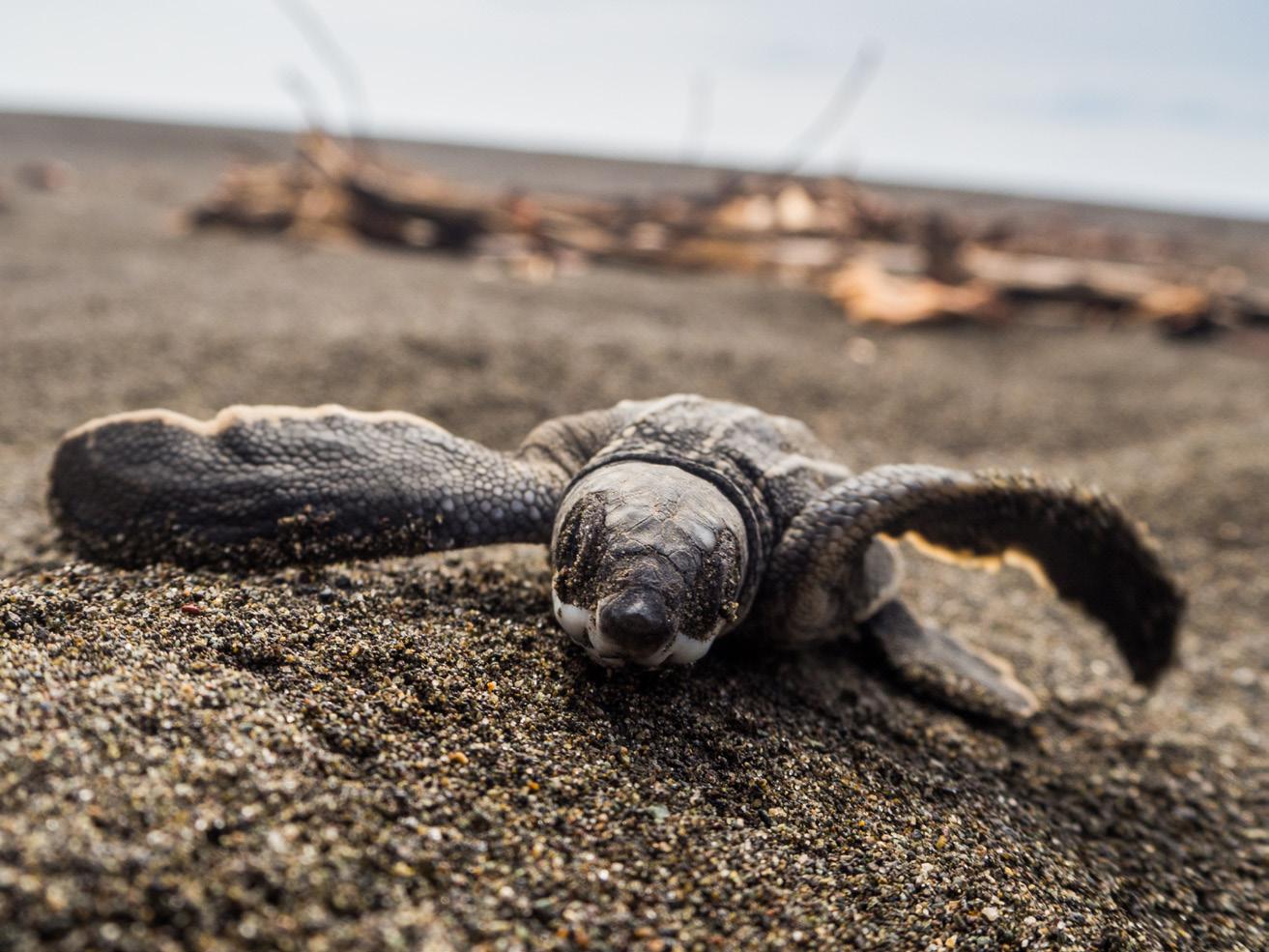
Biosphere Expeditions surveyed a coral reef site in the Maldives called Rasdhoo Madivaru from 2010 to 2019, when the Maldivian authorities eventually declared the site a marine protected area. The reef is resilient to the worst effects of coral bleaching, and it harbors large marine animals such as sharks, manta rays, turtles, and Napoleon wrasse. Additionally, Biosphere Expeditions — along with the Marine Conservation Society, Reef Check, LaMer, Carpe Diem Maldives and the Rufford Foundation — created a local program, training Maldivians on reef surveying techniques. As a result, community-based surveys took place in Velassaru and Dhigurah, as well as community education efforts that included a children’s booklet explaining how climate change and other factors
affect marine ecosystems, and scholarships for Biosphere Expeditions’ coral reef and whale shark study that took place in 2011.
In Oman, Biosphere Expeditions’ citizen scientists gathered data for five years before ministerial decree banned fishing in two secluded bays in the Musandam peninsula and declared them marine protected areas. Biosphere Expeditions also ran an education and empowerment program that resulted in community-based reef surveys and the creation of Oman’s first reef protection nongovernmental organization. During the surveys, citizen scientists found that corals in Oman thrive in extreme conditions (such as high temperatures and salinity) — a discovery that could hold a key to coral survival in the face of global warming.

wildlife, and local communities.”
GET INVOLVED
Biosphere Expeditions runs nearly a dozen expeditions each year, three or four of which (the number varies each year) are marine science projects. For example, upcoming marine conservation volunteer projects include a seven-day diving expedition (Oct. 5-11) to study coral reefs and whale sharks in the Maldives. And in 2025, Biosphere Expeditions is offering a 10day trip (Mar. 29-Apr. 7) to the Azores in Portugal to survey whales, dolphins, and turtles.
“We are [also] actively working on setting up a coral reef project in Oman at the moment,” Dr. Hammer says.
“The benefit of marine citizen science is evident in these figures and achievements from our expeditions around the world,” Dr. Hammer says. “The work of our citizen scientists has been paramount to research, conservation, education, and empowerment in a showcase of citizen science’s democratizing effect and creating win-win-win situations for nature,
Additionally, Biosphere Expeditions created a local placement program in 2012 that hosts students, NGO and government employees, and committed individuals on expeditions. Since the program began, more than 100 locals (in various locations) have participated — resulting in community-based conservation and education programs, the creation of local conservation NGOs, career changes, and employment in conservation jobs.




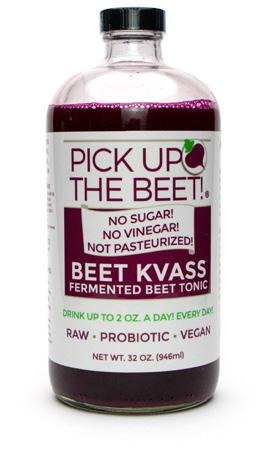



BY VALERIE POIRIER, CERTIFIED NUTRITIONIST
WWhen we think about water, it's usually in the context of staying hydrated — replenishing lost nutrients after a good workout or cooling us off on a hot summer day. But water does a lot more for our bodies than just quench our thirst. Let's dive into some of the amazing roles water plays in keeping us healthy and feeling our best.
One of the most important roles water plays is to help keep our body temperature in check. When we sweat and breathe, water helps us get rid of excess heat, keeping us from overheating. So, when we get hot, we sweat, and as the sweat evaporates, it cools us down. Water also helps our bodies regulate our internal temperature in response to the temperature outside.
Water acts as a protective shield for our tissues and organs. It keeps our joints lubricated and cushioned,
helping to prevent damage. Staying hydrated is especially important for our brain, spinal cord, and eyes — they all need plenty of water to function properly. By keeping these areas moist and protected, water ensures everything runs smoothly and efficiently.
Water is vital in the digestive process. It helps break down food, allowing our bodies to absorb nutrients effectively. Saliva, which is mostly water, initiates the digestion process by breaking down carbohydrates. In the stomach, water helps dissolve soluble fiber
and nutrients, making them easier to absorb in the intestines. Staying properly hydrated ensures that our digestive system functions well, preventing issues like constipation and indigestion.
Water is a crucial element in the body's detoxification processes. It aids the kidneys in filtering out waste products from the blood and excreting them as urine. Proper hydration is essential for the kidneys to function efficiently and to prevent the accumulation of harmful substances in the body. Additionally, water helps eliminate toxins through sweat and respiration.
Blood, which is approximately 90% water, plays a key role in transporting nutrients and oxygen to cells throughout the body. Water helps maintain the blood's volume, ensuring it can flow easily through blood vessels and reach every part of the body. This transportation system is crucial for delivering essential nutrients and oxygen that our cells need to function correctly.
Electrolytes like sodium, potassium, and chloride are essential for various bodily functions, including muscle contraction and nerve function. Water helps maintain the balance of these electrolytes in the body. Dehydration can lead to electrolyte imbalances, causing symptoms like muscle cramps, fatigue, and confusion. Staying well-hydrated ensures that our electrolyte levels remain stable.
Every cell in our body relies on water to function correctly. Water is involved in numerous cellular processes, including energy production, protein synthesis, and regulation of cell volume. Without adequate water, these processes can be disrupted, leading to impaired cellular function and overall health.

As you can see, water plays a vital role in maintaining our health, from regulating body temperature and protecting essential organs to aiding digestion, nutrient absorption, and detoxification. Recognizing these functions highlights the importance of staying wellhydrated and appreciating the critical role water plays in our daily lives. So the next time you drink a glass of water, remember that you're not just satisfying your thirst — you’re doing good for your body by supporting a wide range of its essential functions.


BY SHELBY TUTTLE
PPatagonia, a leader in sustainable outdoor gear, has taken a significant step towards circularity in the wetsuit industry. This innovation comes through a collaboration with Bolder Industries, a company specializing in sustainable solutions for the rubber and plastics sectors.
Patagonia's commitment to eco-friendly materials began in 2008 with its partnership with Yulex. This collaboration resulted in the development of biobased rubber derived from Pará rubber tree sap, a significant departure from the traditional petroleumbased neoprene. This pioneering move not only reduced environmental impact but also ushered in a new era of sustainable wetsuit materials.
Recognizing the potential for further environmental benefits, Patagonia initiated a program to collect retired Yulex wetsuits. These decommissioned suits undergo a novel transformation at Bolder Industries.
Through a groundbreaking process, Bolder breaks down the wetsuits at the molecular level, recovering valuable "carbon black." This recovered carbon black plays a crucial role in dyeing the recycled nylon lining of future Yulex wetsuits.
“We hope that this breakthrough in recycling and circularity will go well beyond the surf industry and will eventually be implemented across countless product sectors,” says Hub Hubbard, Patagonia’s surf product line manager. “We have successfully piloted this program using reclaimed carbon black (RCB) from retired Yulex wetsuits as a main component in wetsuits and that cycle can repeat indefinitely.”
Patagonia’s partner in the initiative, Bolder Industries, has expertise that also extends beyond wetsuits. Its technology allows the company to reclaim carbon black from end-of-life tires (ELTs), resulting in a new technology called BolderBlack — an environmentally responsible alternative to virgin carbon black. The company’s BolderBlack technology produces a staggering 90% reduction in both water usage and greenhouse gas emissions. Bolder mixes recovered carbon black from wetsuits with ELT-derived black to ensure sufficient volume for each new wetsuit.

The recovered carbon black constitutes 10-20% of the rubber content in Patagonia's latest wetsuit iteration. This achievement demonstrates a commitment to not only minimizing environmental impact but also continuously improving existing processes.
Mackenzie Warner, a Patagonia material developer, says, "While collaborating on this material with Bolder Industries, we discovered that recovered carbon black from rubber scraps and Yulex wetsuits can be utilized to not only solution dye wetsuit materials but also black fabrics and trims to make products such as packs and jackets.”
Patagonia's Wetsuit Forge, a dedicated research, development, and repair facility, serves as the collection point for end-oflife wetsuits. Here, zippers are removed before the suits are shipped to Bolder Industries for carbon black extraction. The reclaimed material is then forwarded to Patagonia's manufacturing
partner, Sheico, for the production of the new, more sustainable wetsuits.
The first wave of wetsuits utilizing this groundbreaking recovered carbon black technology is expected to hit the market in 2025. This development signifies a significant advancement in wetsuit sustainability, paving the way for a more circular future within the industry.

OF WATER – USE IT WISELY



IIn Arizona, water conservation benefits the entire state. Conserving water around your home is a great way to do your part while saving you money! Although you may be a drop, your actions create a ripple. Check out these tips from Water – Use It Wisely (WUIW) for easy ways to save water this summer and all year round!
Leaks, Leaks Everywhere: Toilets leak, irrigation systems leak, faucets leak, swimming pools leak. It all adds up. ‘Nuff said!
FACT: An average household wastes nearly 10,000 gallons of water each year due to leaks.
Keep Your Landscape from Soaking You: Up to 70% of household water use occurs outdoors –especially for lush landscapes and swimming pools. Check out Water — Use It Wisely’s online resource for tips on xeriscaping, efficient irrigation, rainwater harvesting, pool maintenance, and more.
FACT: A swimming pool evaporates its entire water volume in one year – about 20,000 gallons.
Know & Compare: Are you using the right amount of water at home? Discover the ideal water usage for your household by using a home water calculator app and see how it compares with your actual usage.
FACT: Research has found that customers using auto
bill payments consume more energy and water than those who do not.
Cash In on Water Savings: Discover amazing rebates for water-efficient toilets, grass removal, and more. Visit the WUIW link below to find out if you qualify for these fantastic savings.
FACT: A few hundred to thousands of dollars may be available for grass removal. HOAs and commercial properties can qualify for $50,000 or more.
Landscapes That Thrive: Xeriscape design and low-water-use plants can create stunning results! Transform your yard with a gorgeous, lowmaintenance, desert-friendly xeriscape that offers colorful blooms, shady spots, and a habitat for butterflies and hummingbirds.
FACT: Converting your lawn into a xeriscape will reduce your water consumption by half and save thousands of gallons of water each year.
Harvest Your Rainwater: Why pay for water when it’s free? Despite our limited rainfall, it’s still worth it. Rainwater harvesting can be as simple as directing runoff to basins around your plants or collecting it in a rain barrel. More complex water distribution systems may include gutters, storage tanks, and pumps.
FACT: The rooftop of a typical home can collect 500 gallons of water from ½-inch of rain.
It Just Makes WaterSense: Discover the power of water-efficient fixtures with the exclusive “WaterSense” label. These items will use at least 20% less water than the federal requirements without sacrificing performance. It's a brilliant choice for your wallet and the planet!
FACT: The WaterSense label can be found on showerheads, faucets, toilets, irrigation controllers, homes, and more.
Don’t Water the Gutter: Keep an eye out for misdirected or broken sprinklers and runoff from excessive watering — it's a common sight in neighborhoods everywhere. Fix broken sprinklers as needed, and position your sprinklers so that the water lands exactly where it should.
FACT: A broken sprinkler head can lose 12 gallons of water per minute or more.
Eager to dive into the specifics? Find useful tips along with relevant links and detailed information at wateruseitwisely.com/green-living.

habitatcaz.org/cars

and let’s give Arizona a hand up!

BY SHELBY TUTTLE
DDoes the thought of summer send shivers down your spine? We Arizonans love our pools to keep us cool during the grueling summer months, but our most favorite backyard feature isn’t always environmentally friendly. It’s possible to enjoy your oasis while doing better for the planet. Here are some easy changes to transform your pool into a more eco-friendly paradise:
Cover Up! A pool cover isn't just a winter necessity. During swim season, it dramatically cuts down on water evaporation, which means less refilling and fewer chemicals needed. Plus, it keeps leaves and debris out, saving you time on skimming and reducing the workload on your filter.
Cartridge Filters: The Green Cleaning Choice. Sand filters are a thing of the past! High-quality cartridge filters are the new eco-friendly champion. They last longer, require less cleaning (save more water!), and trap smaller particles — meaning your filter won't have to work as hard. The result? Crystalclear water and lower energy bills.
Harness the Power of the Sun. Solar-powered pool vacuums are a fantastic eco-friendly option. They silently glide around your pool, powered by the sun, keeping it sparkling clean without adding to your energy bill.
Say No to Harsh Chemicals. Chlorine keeps the
water clean, but it can irritate skin and eyes and isn't exactly kind to the environment. Traditional chlorine alternatives — like salt or mineral pools — can be more eco-friendly while keeping your pool sparkling and swimmers happy.
Lighten Up Without Burning Out. Swap those traditional pool lights for energy-efficient LED bulbs. They'll illuminate your nighttime swims beautifully while using far less energy and last much longer. It's a win-win for your wallet and the environment.
Every Drop Counts. Small changes can make a big splash! Fix any leaks in your pool system promptly, keep your pool cover on when not in use, and run your filter only as long as necessary to reduce water consumption wherever possible.
This summer, take a cool dip in your pool knowing you're doing your part for the planet. With a few simple adjustments, it can be a place of eco-friendly fun for the whole family!













How the National Forest Foundation is Working to Protect Water in Arizona by Restoring Forests and Connecting Communities
BY SASHA STORTZ, REBECCA DAVIDSON, AND JENY DAVIS
IIn Arizona, the story of people and sustainability most often starts with water. Since time immemorial — long before Arizona was a state — Indigenous people have lived here, thrived, and moved to where water was abundant.
From statehood, Arizona’s growth has been driven by the supply of water, enhancing industry and economy, setting the foundation for life in a diversity of landscapes — from the stark Sonoran Desert cities of Tucson and Phoenix to the verdant forests surrounding Payson, Prescott, and Flagstaff.
Over time, people from near and far understood that water flow in desert communities is directly connected to abundant precipitation in higherelevation landscapes. The Arizona Territorial Legislature even petitioned Congress in the 1800s to set aside lands in the high country for long-term protection of water supplies for growing communities below. These connections, where snowmelt and rain are absorbed by the land and then drain into a common waterbody like a river, are called watersheds.

And these watersheds support water supplies for people and communities across Arizona.
This is a woven landscape of people, watersheds, forests, and deserts. Partners across the state are working together to safeguard water by improving the health of forests, reducing the risk of wildfire, and improving streams, wetlands, and reservoirs across both northern and southern Arizona.
Have you ever wondered where the water flowing from your kitchen faucet comes from? Or just how the Salt River flows so readily during your tubing adventure? They're powered by high-elevation snowmelt and rainfall in the watersheds that drain downstream. In the Phoenix Metro area – the fifth
largest metropolitan region in the US — water from the Salt and Verde River watersheds support most surface water supplies for 10 Valley cities, which treat that water and deliver it to farms, homes, and businesses, benefitting millions.
With Arizonans’ surface water largely coming from high-elevation forests, it is important to know that a forested watershed with good conditions is one where rain and snow slowly soak into the soil, stream flow is steady, and little sediment erodes downstream. But with declining forest health in the face of drought and overgrown forests, the risk of catastrophic wildfire, impacts of postfire flooding, and chances of sediment impeding our water supplies are getting worse.
With these pressing challenges, partners across the West are working together to restore forests and watersheds and to sustain vital water supplies.
The Northern Arizona Forest Fund (NAFF) is a locally focused initiative developed by the National Forest Foundation (NFF) — a congressionally chartered nonprofit whose mission is to bring people together for the enhancement of National Forests and Grasslands. The NAFF was designed to foster innovative partnership and collaboration for the stewardship of the Salt and Verde watersheds. By providing opportunities for businesses, local governments, and residents of Arizona to invest in the lands they depend on, the NAFF provides a direct link between water users and the health of their water sources.
sustainable water flows by reducing fire risk, improving wetlands, and reducing sedimentation into streams and rivers throughout the Salt and Verde watersheds.
By connecting water users and the health of watersheds, NFF works to protect watersheds and forests while engaging funders in a shared responsibility for water resources. Municipalities like the City of Scottsdale and City of Phoenix have been participants in the NAFF since the program’s inception in 2015. Other major partners include the Salt River Project and Sedona’s Pink Jeep Tours.

Since the NAFF was established in 2015, NFF has restored over 27,000 acres of forests and 3,020 acres of riparian areas, along with over 325 miles of trails — all part of a multitude of treatments to strategically address high-priority areas of these watersheds.
Through efforts like forest thinning and prescribed burns, the NFF restores forests to be more resilient to severe wildfires. This both protects the forest and reduces the risk of post-fire flooding and sediment flows to local communities and downstream water users. One example is the Pine Canyon Restoration Project on the Tonto National Forest. This project involves thinning 450 priority acres of unhealthy forest in an area that could burn with devastating consequences: a high severity fire and post-fire flooding would have big impacts both to the community of Pine — whose water supply comes, in part, from Pine Creek — as well as downstream water users who rely on the Verde River watershed.
These investments focus on green infrastructure by enhancing natural systems that contribute to clean and
The NFF works to enhance aquatic habitats by
protecting and restoring sensitive meadows that act like sponges for groundwater, restoring native plants, and using techniques that help create healthy floodplains. These activities improve water quality and quantity and support some of the most biodiverse areas in Arizona.
The Little Green Valley Fen is a unique place on the Tonto National Forest. For decades, erosion and degradation have dewatered the wetland. By installing structures to help spread out water and replanting native vegetation, restoring this green gem will provide more than 16 million gallons of enhanced water storage annually.

Implementing erosion-control measures such as improving unsustainable trails and roads helps limit sediment in Arizona's waterways, protecting water quality for aquatic species and water users.
In Oak Creek Canyon, hundreds of unauthorized trails spiderweb to the creek, which increases erosion and poses water quality concerns. Alongside the Arizona Dept of Environmental Quality and the Coconino National Forest, the NFF is improving trail sustainability and increasing trash pick-up, all with an eye towards improving water quality in this precious waterway. So far, over 320 unauthorized social trails have been rehabilitated and another 40 improved, reducing sediment into the creek by about 40 tons a year.
As we face the challenges of drought and increasing water scarcity, initiatives like the NAFF become ever more critical — and everyone has a role to play!
The next time you turn on a tap, remember the journey those drops of water have taken. From the peaks of Northern Arizona, through streams and rivers, to
reservoirs and canals, water treatment plants, and finally, to homes and businesses — we rely on healthy forests for sustainable water.
Together, from large businesses to every resident across Arizona, we can all help ensure that the vital connection between forests, watersheds, people, and communities remains strong for generations to come. Learn more at www.nationalforests.org/who-we-are/ azforestfund.

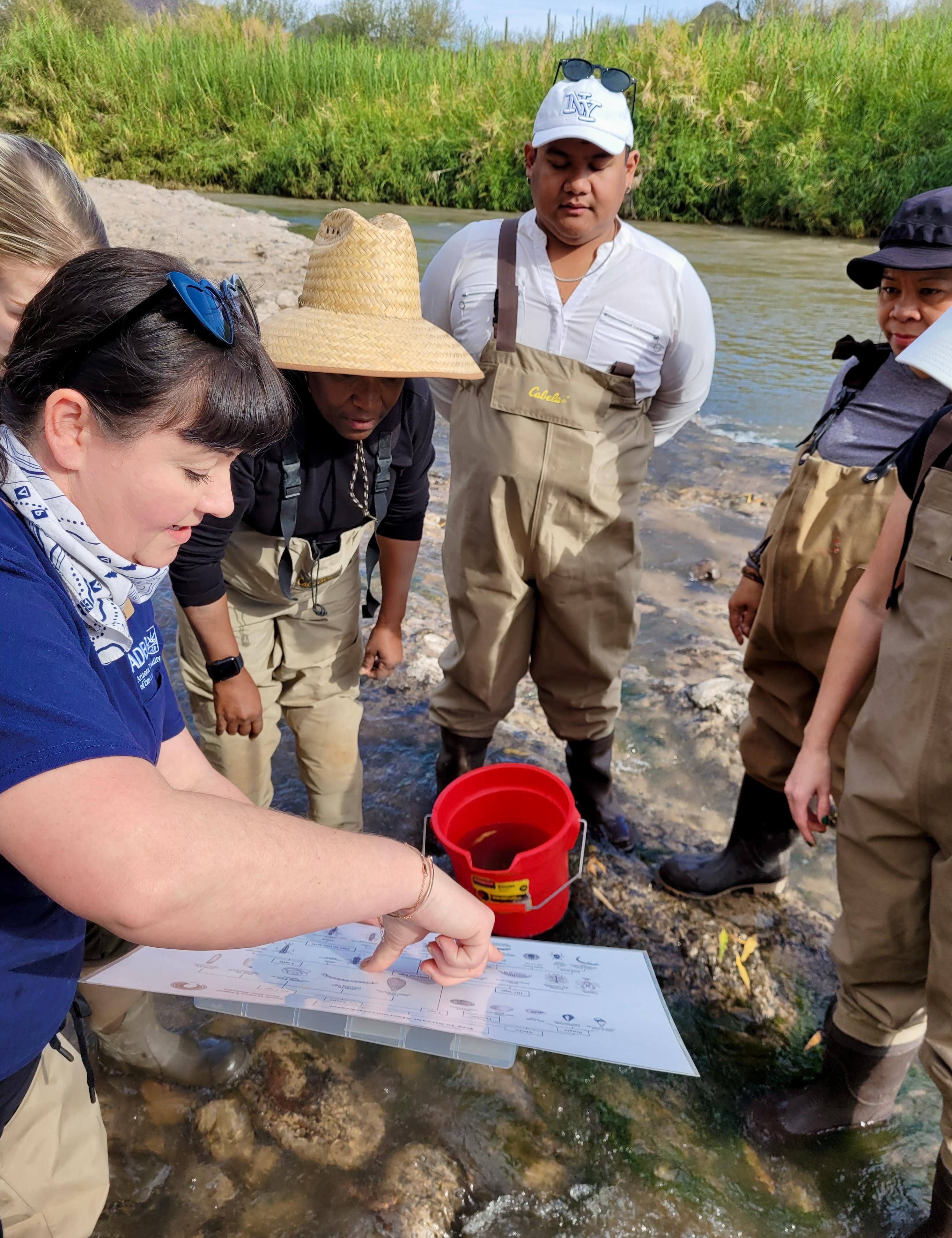
BY COLLEEN KERN AND RITHWIK KALALE
IIn an era of increasing concern about water accessibility, Arizona faces unique challenges in ensuring safe, clean drinking water for its residents. With the recent Environmental Protection Agency (EPA) regulation on per- and polyfluoroalkyl substances (PFAS) in April 2024, the spotlight on water quality has intensified.
PFAS, a group of man-made chemicals, have become a significant concern in water quality discussions. Known for their resistance to water, grease, and stains, PFAS are found in everyday products such as nonstick cookware, stain-resistant fabrics, and waterrepellent clothing. However, their persistence in the environment and potential health risks have led to increased scrutiny and regulation.
Long-term exposure to PFAS is linked to multiple health issues, including certain cancers, liver damage, thyroid disease, and developmental effects in children. The release of the movie "Dark Waters" in 2019, based on the DuPont water contamination scandal in West Virginia, brought widespread public attention to the PFAS issue. The DuPont case, along with others like the water crisis in Flint, Michigan, from 20142016, have underscored the urgent need for stricter regulations and better monitoring of drinking water quality across the nation. But what does this mean for Arizona residents?
ARIZONA'S APPROACH TO WATER QUALITY
In Arizona, water quality is a top priority, especially given the state's unique environmental conditions and reliance on groundwater. The Arizona Department
of Environmental Quality (ADEQ) plays a crucial role in overseeing and ensuring the safety of drinking water across the state.
Key aspects of Arizona's approach include:
• Comprehensive Testing: ADEQ regularly tests for over 90 contaminants, including bacteria, arsenic, uranium, nitrates, and PFAS.
• Proactive PFAS Monitoring: In 2022, ADEQ launched a statewide effort to test public water systems for 29 different types of PFAS. This initiative also provides free PFAS sampling to smaller systems, allowing for early detection and mitigation.
• Rapid Response to Contamination: When contaminants exceed safety standards, ADEQ requires public notification and works with water systems to address the issue promptly.
• Support for Small Systems: ADEQ assists small public water systems in building their technical, managerial, and financial capacity to maintain healthy drinking water.
• Predictive Analytics: ADEQ uses a Predictive Analytics program to identify changes and trends in drinking water quality, allowing for preemptive action to prevent water quality violations.

Alma Suarez, deputy public information officer for water quality at ADEQ, emphasizes the state's commitment.
"ADEQ oversees approximately 1,550 regulated public water systems, serving more than seven million residents. We work with local counties to ensure that tap water quality meets or exceeds state and federal Safe Drinking Water Act (SDWA) standards," she says.
Suarez explains that as a result of these efforts, drinking water supplies in Arizona are among the cleanest in the country. More than 99.7% of Arizonans who receive their water from a public water system are being served healthy water that meets or exceeds all SDWA standards.
Alan D. Forrest, president of the Arizona Water Association, identified the most common

contaminants found in Arizona's drinking water: "Nitrates, Arsenic, PFAS, and VOCs (Volatile Organic Compounds – trichloroethylene (TCE), tetrachloroethylene (PCE), methyl tert-butyl ether (MTBE), etc.). All of these are common groundwater contaminants – both in [Arizona] and nationwide."
Forrest explains that Arizona is a naturally mineralized state; therefore, naturally occurring minerals like arsenic and uranium are present in some groundwater supplies, largely depending on the type of soil and rocks the groundwater is exposed to. These constituents are regulated by the EPA, requiring water companies to either discontinue the use of contaminated water or treat it to remove the contaminants.
Regarding man-made pollutants, Forrest notes that while PFAS regulations are just now being adopted, nitrates have been regulated for decades under both the SDWA and the Clean Water Act. Forrest notes that current treatment technologies are very good at both identifying and removing both known and emerging contaminants.
According to Suarez, ADEQ has several goals to improve and maintain water quality in Arizona:
• Expand technical, managerial, and financial capacity: ADEQ plans to enhance its program that supports small water systems in building their technical, managerial, and financial capabilities.
• Grow the monitoring assistance program: This program helps small systems comply with the Safe Drinking Water Act by assisting with required annual sampling.
• Enhance predictive analytics: ADEQ will continue to develop its predictive analytics program to identify potential water quality issues before they become violations.
• Advanced water purification: ADEQ is working on finalizing regulations for advanced water purification — a groundbreaking initiative to convert treated wastewater into safe, reliable, purified drinking water. The initiative addresses both water quality and quantity concerns in Arizona's arid environment.
• Address emerging contaminants: ADEQ remains vigilant about emerging water quality concerns, particularly PFAS contamination. The department has already launched a comprehensive
statewide effort to test for 29 types of PFAS and is continually updating its approach based on new federal guidelines.
These initiatives demonstrate ADEQ's commitment to proactively addressing Arizona's water challenges and ensuring safe, clean drinking water for all residents.
While water utilities work to implement new standards and improve water quality, there are initiatives that you can take to reduce your exposure to PFAS and other contaminants on your own:
• Use certified water filters: Look for charcoal (granular activated carbon or GAC) or reverse osmosis filters and systems certified for PFAS reduction. These are often marked with certification to “NSF/ANSI 53” or NSF/ANSI 58.”
• Stay informed: Review your water system's annual Consumer Confidence Report (CCR) for detailed information about your water quality.
• Avoid PFAS products: Limit the use of products containing PFAS, such as certain nonstick cookware and water-repellent clothing.
• Support clean water initiatives: Advocate for stricter regulations on industrial pollutants and support initiatives aimed at improving water quality in your community.


• Test private wells: If you rely on a private well for drinking water, consider having it tested for contaminants regularly.
For residents seeking more information about water quality in Arizona, several resources are available:
• ADEQ website (azdeq.gov): Provides access to detailed reports, interactive maps, and resources on water quality.
• Consumer Confidence Report (epa.gov/ ccr): The report provides detailed information about your drinking water, which is often provided by your water supplier or can be found on the EPA’s website.
• EPA's PFAS information page (epa.gov/ pfas): Offers comprehensive resources on PFAS, including health information and regulatory updates.
As we move forward, the importance of clean water cannot be overstated. It's not just about meeting regulatory standards; it's about safeguarding public health, supporting our communities, and preserving Arizona's water resources for future generations. Through continued research, public engagement, and adaptive management strategies, Arizona can strive to ensure that every resident has access to clean, safe drinking water.

BY LAINE SEATON
LLooking out over the vast expanse of the deep blue waters of Lake Pleasant, it’s hard to imagine the complex forces just below the surface, battling to ensure that Arizona will have enough water for future generations.
Nestled in the northwest corner of the Valley, Lake Pleasant is just one of 128 lakes throughout the state, enjoyed by millions of locals and tourists each year. It drew nearly 1.2 million visitors last year, many seeking fun recreation or a much needed escape from the scorching summer heat.
But in the last few years, lakes across Arizona and the Southwest — Lake Powell and Mead in particular — have been in a troubling spotlight, revealing the alarming and undeniable impacts of a decadeslong megadrought, climate change, and conservation measures that have been rendered inadequate.
Old, rundown fishing boats, long hidden beneath the waves, were suddenly found randomly perched on dry rocks, and also striking was Lake Mead’s infamous “bathtub ring” band of white around its perimeter, which showed a drastic change in water levels that had dropped to just 27% capacity — it’s lowest level on record. What followed was a Tier 1 water shortage declaration, forcing states to cut back. But how did we get here?
River. Along its expansive 1,450-mile stretch, winding through seven states from Wyoming to Mexico, the Colorado River is a major water source for many of the western states, serving 40 million people.

To better understand Arizona’s lakes, you need to start at the beginning and the mighty Colorado
Built around a framework of Upper Basin states (Colorado, New Mexico, Utah, and Wyoming) and Lower Basin states (Arizona, California, and Nevada), the river’s water allocation was first established in 1922 through the Colorado River Compact. In simple terms, the Upper Basin states primarily get their water directly from the Colorado River and its tributaries, whereas the Lower Basin states get their water primarily from Lake Powell and Lake Mead, which are fed by the Colorado and its upstream tributaries. Arizona receives roughly 35% of its water supply from the Colorado, with the rest coming from groundwater, in-state surface water (like the Salt and Verde Rivers) and reclaimed water.
Keeping this essential water flowing has required extensive collaboration between the United States Bureau of Reclamation (the lead agency responsible for managing the Colorado River system), local municipalities, and numerous public/private entities,
along with complex planning, massive infrastructure via dams and canals — think Central Arizona Project (CAP) and countless conservation strategies. But these collective efforts have been pushed to the limit by record-setting temperatures, conservation measures that aren’t cutting it, and the new reality caused by climate change that is sounding the alarm.
“We’ve been in a structural deficit where we’re pulling out more water than can be replenished,” notes AZ Water Association President Alan Forrest. “Back in the 1920s, our water allocations were set during a time when the flows into the Colorado River were at their highest levels, but it’s obviously different now. The ongoing drought, climate change, and water use decisions have all played a part in our current situation, and it’s going to take time to get out of it,” he says.

Sarah Porter, director of the Kyl Center for Water Policy at Arizona State University, cautions that this “structural deficit” is a “huge driver of declining reservoir levels.” The term refers to both the gap between supply and demand, and to a lack of accounting for water that is lost due to evaporation when it’s moved through a big system.
If you turned on the news in 2021 or 2022, chances are you saw the widespread stories of historic drops in the water levels at Lake Mead and Lake Powell. Grisly
reports of bodies being found in Mead’s lakebed only added to the drama. But behind the intrigue, the plunge in the lakes’ water levels in 2021-2022 was a serious tipping point, culminating from years of declining water levels going back to 2000.
As hotter temperatures became the new normal, drier winters and lighter snowpack levels made it nearly impossible to replenish the amount of water that was evaporating or being used every year. And despite winters where snowpack levels have been robust, experts say that warmer temperatures and longer, drier seasons are weakening the amount of water the snowpacks would normally deliver.
“The Colorado River is a snowmelt driven system,” says John Berggren, Regional Policy Manager for Western Resources Advocates. “We’re seeing more precipitation fall as rain rather than snow, and the snow we do have is melting earlier and more water is being absorbed by the soil, which means less water in the system overall.”

According to Porter, “Decades of below average flows compound the structural deficit, resulting in declining reservoir levels.”
Measures to help mitigate these impacts through strategic water distributions and more intense conservation efforts, although
helpful, have proved to be no match for the megadrought that has now lasted for nearly 25 years.
As a stark example, in the summer of 2021, millions of gallons of water from Colorado’s Blue Mesa Reservoir were released in an effort to shore up a depleted Lake Powell to the south. Already at a strikingly low 32% capacity, the reservoir’s two main marinas were forced to close three weeks early. 2022 was even worse, with an emergency order that the marinas close for the entire season, causing serious financial and economic ramifications.
Closer to home at Lake Pleasant, boaters have also felt the impacts of fluctuating water levels. Although water levels at Lake Pleasant regularly fluctuate due to its function as a CAP reservoir, the topic of drought is top of mind for many.
Lake Pleasant Harbor Marina Manager Joe Evans says, “When the water levels drop, the available boating surface starts to shrink. He continues, “Islands that are 20-40 feet underwater actually start to appear. The drought is always looming in our thoughts, and we know it’s always a real possibility that it could get worse.”
While the recent summers were undeniable wake-up calls for reexamining how Colorado River water is managed, allocated, and conserved, a much-needed reprieve in the form of heavier snowpacks and rain in the winters of 2022 and 2023, have slowly begun to replenish Arizona’s water supply, but there’s still a long road ahead.
“Last year was a good water year,” says Alan Forrest. “We saw better than average snowpack which flows into the system and ultimately gets down to the lakes. This allowed us to ‘hold steady.’ We were on a steep decline up to this point, but we’re still just holding,” he says.
Currently, Lake Powell is 42% full, Lake Mead
follows at 33%, and the Lower Basin is still under a Tier 1 shortage. Additional help through $4 billion in federal funding is also going to support new water conservation projects and financial incentives to cities to reduce their draw from the Colorado River, but more steps will likely be needed soon.
“A lot of this interim stuff ends in 2026,” says Forrest. “They need to figure out a permanent solution or we’ll be right back where we were.”
Porter notes that in 2026, new guidelines for managing the system will be implemented.
“Those guidelines will likely detail what water users’ supplies will be cut — and how much — under various shortage conditions,” she says.
“Climate change is here, and it’s not going away any time soon,” Berggren said. “The overall trend is less water in the system, so we have to plan for that.”
Two strategies for addressing declining Colorado River supplies that are gaining momentum in Arizona include augmentation and recycling. Plans to ‘augment’ water supplies from the Verde River are already underway. The Bartlett Dam modification project aims to raise the height of the dam by 100 feet, allowing for more water storage capacity. Additionally, the City of Phoenix is leading plans to develop an advanced water purification facility that would treat effluent water to raise it up to drinking water standards, enabling the city to reduce its reliance on Colorado River water by as much as 50%. According to Porter, other cities may also invest in that project.

However, climate experts are predicting an 85% likelihood of 2025 being a La Nina year, which is typically hotter and drier, so the clock is ticking.
Says Berggren, “Everyone is going to have to do their part — cities, ranchers, businesses, homeowners. We’re all going to have to share in the solution.”

Arizona’s own WILD TONIC gives traditional kombucha a tempting twist
BY TIFFANY CANDELARIA
AAn Arizona artist turned from painting with beeswax to brewing with honey to create a delicious drink that was previously largely unknown and unavailable locally to the general public. WILD TONIC is much more than a bubbly beverage — it is a 100% organic, green tea-based, probiotic elixir known as jun (pronunciations vary from rhyming with noon or nun, depending on who you ask).
A cousin of kombucha, jun is made with green tea and honey instead of black tea and sugar, which creates a smoother, more palatable taste. This uniquely delicious beverage was brought to the Arizona masses by artist Holly Skaggs, who worked with bees and was passionate about making the world a better place. One day her love of painting with beeswax transformed into working with honey.
“Another labor of love created by the bees,” Skaggs says. “And as with many creative endeavors that
spill into other forms of expression, I found myself fascinated with the art of fermentation, specifically a rare ferment known as jun.”
She experimented brewing with this living culture for several years until 2015, when WILD TONIC Sparkling Jun was officially launched!
The origins of jun are largely unknown. Some believe the beverage dates back to ancient Chinese or Tibetan origins, while others believe it to be a more modern
spin on kombucha. In either case, jun is a relatively new beverage category that has recently started to become recognized by consumers.
“We have a lot of educating to do so that people try this amazingly delicious ferment that is great for gut health and energy,” Skaggs explains. “Green tea and honey are both superfoods and when they are fermented, it makes the nutrients even more bioavailable to the body.”
Today there are nearly 15 flavors of WILD TONIC — including two seasonal varieties — that include creative combinations like Rosemary Lemon and Chai Pear, along with more common flavors like Blackberry Mint and Blueberry Basil. Available in bold cobalt blue glass bottles — the same color that attracts bees to flowers — or convenient aluminum cans, these drinks provide delicious refreshment plus probiotics, prebiotics, amino acids, and antioxidants that support immunity and digestion in each serving.
Brewed with organic honey from Brazil, a big part of the mission at WILD TONIC is to help the bee populations by supporting organic farmers and partnering with local beekeeping organizations that focus on bee conservation. As Skaggs and her team only use organic honey, the team hasn’t been able to source the quantity needed to produce the jun within the U.S. She notes that it is hard to source large quantities of organic honey due to the amount of pesticides and GMOs present in our crops.
practices to minimize its impact on the environment. Practices include composting leftover teas, herbs, flowers, and fruit used in making the jun, recycling of all appropriate materials, and using biodegradable and non-toxic cleaning products. Additionally, the 36,000-square-foot state-of-the-art brewery in Cottonwood is energy efficient.
“There is a common thread of health, joy, and vitality that unites us and our mission,” says Skaggs. WILD TONIC is proud to have won a handful of awards, including Beverage Industry’s “Innovation of the Year”

“By identifying and encouraging the wild characteristics in bees, we can help them adapt and thrive once again in an increasingly developed world,” says Skaggs.
The company also follows a handful of sustainable
when the company first launched, in addition to a gold medal at the U.S. Open Beverage Championship for its Mango Ginger flavor of hard jun — an alcoholic line designed for customers to get their buzz on without the toxins found in many traditional alcoholic beverages. The company also recently received an MLB Sports Certification and will soon be stocked into clubhouses across the country.
Today, WILD TONIC is sold in all 50 states and can be found locally at Sprouts, Whole Foods, and AJ’s Fine Food stores. For more, visit www.wildtonic.com.
Ingredients
1/4 cup extra virgin olive oil
8 garlic cloves
2 teaspoons cumin
1 teaspoon turmeric
1 teaspoon pimenton
1 bunch leeks, roughly chopped
salt and pepper
1 shallot
1 cup vegetable or chicken broth
1 pound fresh spinach
1 bunch cilantro
1 bunch parsley
1 pound asparagus (cleaned, trimmed, and sliced into 1/2 inch pieces — leave tips at 2 inches)
2 cups cooked chickpeas
2 eggs fresno chiles scallions
fresh dill parsley
labneh
sheep’s milk feta
Directions:
Saute garlic, cumin, turmeric, pimenton, and leeks in olive oil until translucent, then season with salt and pepper to taste. Add broth to the leek mixture, then puree with spinach, cilantro, and parsley. Return to stove top and bring to a boil, then immediately drop the heat to low. Add asparagus and chickpeas and continue to simmer for 10 minutes. Portion the sauce into a cast iron skillet and crack two eggs directly into the sauce. Place the skillet in the oven on broil until the eggs are cooked to your desired temperature.
Garnish with thinly sliced Fresno chilis, scallions, fresh dill, parsley, labneh, and sheep's milk feta.


Ingredients for the soup:
2 pounds ripe tomatoes
½ cup tomato juice
1 cucumber (seeded and peeled)
1 green bell pepper (seeded and de-ribbed)
4 cloves of fresh garlic
1 small white onion
2 corn tortillas (soaked in water and softened) or a cup of soaked corn chips
1 tablespoon Spanish Jerez vinegar or rice wine vinegar
1 tablespoon lime juice
2 tablespoons extra virgin olive oil
1 teaspoon cumin
1 teaspoon chili powder or 1 tablespoon ancho chili paste
Salt and black pepper to taste
The toppings:
2 thinly sliced avocados
1 cored and seeded thinly sliced jalapeño
3 green onions thinly sliced
4 tablespoons chopped cilantro
Optional toppings
Sour cream
Poached shrimp
Directions:
Add all ingredients in a food processor and blend to a smooth consistency. Adjust seasoning and acidity to taste (i.e., if the tomatoes are too sweet, add additional vinegar and/or lime juice). Refrigerate to cool and serve chilled in individual bowls. Add suggested toppings, as desired.

BY ANGELA FAIRHURST
SSituated in Northern Virginia, the county of Arlington is more than just a suburb of Washington, D.C. It's a vibrant community pulsating with energy, innovation, and a deep-rooted commitment to sustainability. As the nation's inaugural LEED Platinumcertified community, Arlington sets the standard for environmentally responsible travel destinations in the United States, offering visitors a glimpse into a greener future.
Arlington prioritizes water conservation through initiatives such as its enhanced Ballston Pond and the Northern Virginia Rain Barrel Program, which help manage stormwater runoff and reduce water pollution.
As home to Reagan National Airport, the county is easily connected to every major hub across the nation. The 26-square-mile walkable and bikeable county has 11 metro rail stations, four metro lines, and close to 60 neighborhood and civic associations. From trendy neighborhoods like Shirlington and Clarendon to the
bustling urban center of Rosslyn, Arlington's charm extends far beyond its county limits.
Arlington's LEED Platinum certification is more than just a badge of honor; it's a testament to the county’s unwavering dedication to sustainability. By slashing greenhouse gas emissions and championing environmental stewardship, Arlington has emerged as a beacon of hope in the fight against climate
change and sets a standard for others to follow. This certification isn't just about buildings; it's about prioritizing the health and well-being of every resident and visitor who sets foot in Arlington.
A cornerstone of Arlington's environmental initiatives is its commitment to water conservation. The enhanced Ballston Pond exemplifies this effort. Originally designed as a stormwater detention facility to manage runoff from Interstate 66, the pond has been transformed into a critical component of Arlington's water management strategy. This enhancement helps reduce sediments, litter, nutrients, and other pollutants, significantly improving the quality of water entering local waterways.

“The Watershed Programs team delivers Arlington County’s regulatory and stewardship programs for our local water quality and stream health and resiliency,” explains Jason Papacosma, watershed programs manager for the Office of Sustainability and Management in Arlington County. “We cover a lot of ground, inspecting businesses and construction sites to prevent pollution, responding to spills and dumping, repairing eroded streams and their banks, and making sure new homes, buildings, and even county projects have the right stormwater management systems and ecological features. The work has become even more critical with the changing climate.”
Community involvement is also a key part of Arlington's strategy, highlighted by the Northern Virginia Rain Barrel Program.

This initiative encourages residents and businesses to install rain barrels to capture and reuse rainwater, reducing the demand on municipal water supplies and mitigating stormwater runoff during heavy rains.
Arlington Re-Gen represents a progressive leap in sustainable water management. This $175 million biosolids upgrade project focuses on resource recovery and safe, sustainable operations at the Arlington County Water Pollution Control Plant. By converting wastewater into valuable resources, Arlington Re-Gen significantly enhances water quality and contributes to environmental health and community well-being.
“What we do here in Arlington for water quality matters to our regional neighbors and beyond,” Papacosma adds. “We share Four Mile Run with Alexandria, Falls Church and Fairfax County, and share the Potomac River with the District of Columbia. We're all part of the larger Chesapeake Bay watershed — the largest and most productive estuary in the United States — and put a tremendous amount of work into helping restore and protect this vital national resource.”
Arlington boasts more than 157 parks and nature centers, inviting visitors to embrace the great outdoors. From leisurely strolls along scenic trails to birdwatching in tranquil green spaces, Arlington's outdoor sanctuaries offer a welcome escape from the hustle and bustle of city life. Managed by the federal government, Theodore Roosevelt Island stands as a testament to

Arlington's dedication to preserving natural beauty, offering visitors a serene retreat amidst the urban jungle.
In Arlington, sustainability and artistic expression merge seamlessly, creating a vibrant cultural landscape. The "Arlington Art Walk" guides visitors through galleries, studios, and public art between Clarendon and Ballston, offering a glimpse into the

community's creative spirit. At the heart of this artistic journey lies the Museum of Contemporary Art Arlington (MoCAA), housed in a historic school building since 1976. With the Reclining Liberty Sculpture in front, nine galleries, and working studios, MoCAA showcases local and international talent, symbolizing Arlington's commitment to both artistry and sustainability.
Arlington National Cemetery is a sacred tribute to the men and women who sacrificed everything for their country. This hallowed ground serves as the final resting place for thousands of veterans, dignitaries, and notable figures, honoring their service and sacrifice. While paying homage to the past, Arlington National Cemetery embraces a commitment to environmental stewardship through sustainable landscaping practices, water conservation efforts, and habitat preservation initiatives. Recycling programs, energy-efficient lighting, and green landscaping techniques, all managed by the federal government, ensure that the cemetery’s over 10,000 trees and 639 acres remain pristine while minimizing its environmental footprint. During the spring season, the cemetery is adorned with a magnificent display of cherry blossoms in bloom, adding a touch of natural beauty. Arlington ensures that this sacred space remains pristine for generations to come.
For those eager to explore Arlington on two wheels, the county’s 109 bike-share stations offer a convenient and ecofriendly way to get around. Cycling isn't just about reducing carbon emissions; it's about embracing a sustainable way of life. With bike-friendly infrastructure and dedicated pathways, Arlington encourages visitors to pedal their way toward a greener future.
The Arlington County Equipment Bureau includes 100+ electric vehicles used by the county and Arlington
Public Schools. The county has some electric buses in use and is moving towards an all-electric fleet. Other electrification efforts include EV stations throughout the destination and e-bikes as an alternative to cars.
Noticeably, all refuse cans throughout the county contain two bins— one for trash to be sent to the landfill and one for waste that can be recycled.
Green Dining Arlington brings together local restaurants to champion green dining practices. From sourcing locally grown ingredients to reducing waste and energy consumption, participating eateries embody Arlington's commitment to sustainability. Whether it's breakfast or lunch at the Southern-inspired flavors of celebrity chef David Guas’ Bayou Bakery; a beautiful latte and one of the fresh-baked pastries from Northside Social Coffee & Wine; a dinner of responsibly sourced seafood at Seamore's; or a bite at the farm-to-table Copperwood Tavern, every meal supports businesses dedicated to environmental stewardship.
Bill Eger, Arlington County’s Chief Climate Policy Officer, leads the charge in advancing sustainability initiatives and combating climate change. Through collaboration with county departments, regional partners, and community members, Eger spearheads efforts to enhance Arlington's resilience and promote collective action. His visionary leadership underscores Arlington's commitment to tackling environmental challenges head-on.

As Arlington continues to pave the way towards a greener future, it invites cities worldwide to join the journey of sustainability, one mindful choice at a time. From LEED-certified buildings, vast water conservation initiatives, and eco-friendly dining options, Arlington proves that a sustainable lifestyle isn't just a dream — it's a reality waiting to be embraced.


Marriott Marquis D.C.’s sustainability concierge teaches guests how to travel sustainably
BY ANGELA FAIRHURST
In the heart of Washington, D.C., the Marriott Marquis reflects Marriott International's commitment to environmental stewardship. As one of the city’s largest LEED Silver-certified hotels, the Marriott Marquis has embraced a robust sustainability program, marking its 10th anniversary with the introduction of Sustainability Concierge Stephanie Miller. With Miller’s expertise and a comprehensive array of green initiatives, the hotel offers guests the opportunity to enjoy their travels while making a positive impact on the environment.
Miller is a local expert on zero waste and she happens to be the founder of Zero Waste in D.C. With a distinguished background as the former director of climate business at the World Bank Group and the author of "Zero Waste Living, the 80/20 Way: The Busy Person’s Guide to a Lighter Footprint," Miller is well-equipped to guide guests in adopting sustainable practices while traveling and during their stay. Her mission is to help guests understand and reduce their carbon footprint while enjoying the amenities of the hotel and exploring the surrounding neighborhoods. Here, Miller shares 10 of her favorite sustainable — and practical — travel tips:
Book Direct Flights:
Nearly a quarter of the fuel used in flying is expended
during taxi, takeoff, and landing, a figure that can rise to 51% for shorter flights. Opting for direct flights can significantly reduce your carbon footprint by avoiding the extra fuel consumption associated with these phases on connecting flights.
Carry a Reusable Water Bottle: To combat plastic waste, travelers can easily carry a reusable water bottle. The Marriott Marquis provides strategically placed filtered water stations throughout the hotel, ensuring guests have access to clean, sustainable drinking water.
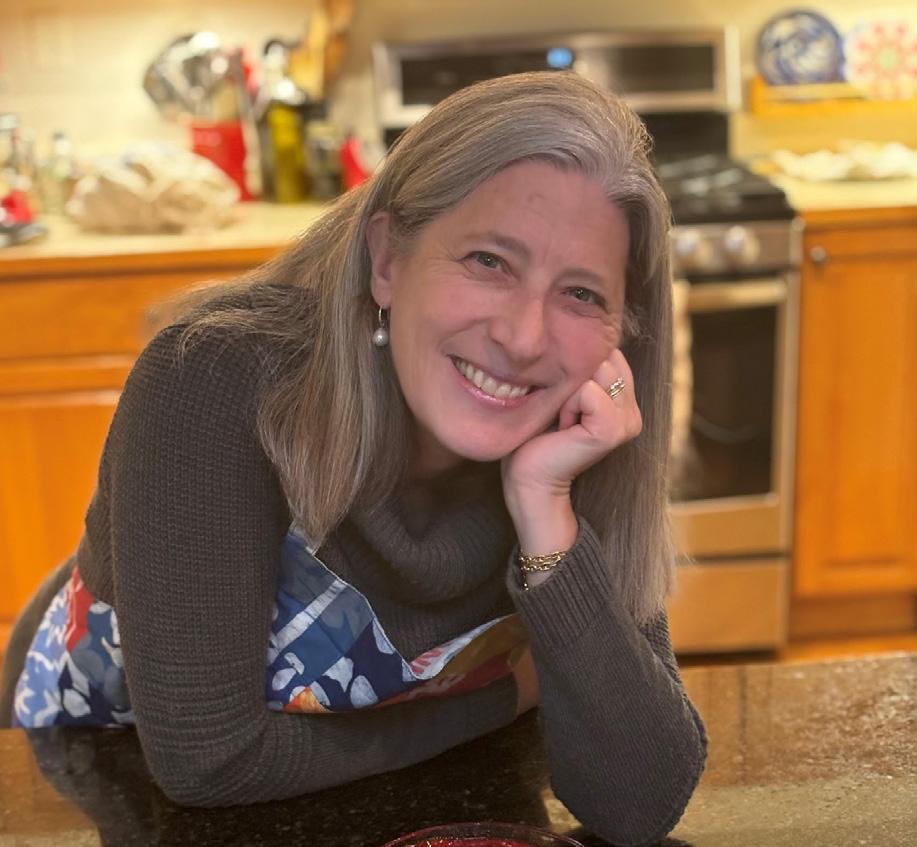
Opt for Digital Receipts: Reducing paper waste is another easy step. Whether you're booking flights, trains, or event tickets, choose digital receipts and boarding passes.
Bring a Reusable Coffee Mug: Many coffee shops, including the Starbucks at the Marriott Marquis, welcome
the use of personal mugs, reducing the reliance on disposable cups.
Pack Your Own Snacks: Avoid the plastic packaging and high costs of airport snacks by bringing your own. This not only reduces waste but also ensures you have your favorite treats on hand.
Eco-Friendly Dining: Work to support ecofriendly restaurants when traveling. The Marriott Marquis helps guests do this by providing a list of establishments with plant-forward menus, locally sourced ingredients, and sustainable practices.
Sustainable Transportation: When traveling, consider how you can best explore the city by using sustainable transportation. Walking, subways and other rail systems, bike shares, and electric scooters can all be effective and fun ways to explore your destination.
Check with your hotel’s concierge desk for guidance on local tours that emphasize sustainability, including walking, bicycling, Segway, and electric scooters as ways to tour the city.
Reuse Towels and Sheets: By reusing linens during short stays, guests can help conserve water and energy. The Marriott Marquis supports this practice with in-room signage encouraging towel and sheet reuse.
Pack a Reusable Tote: A reusable tote bag can eliminate the need for single-use bags when shopping for souvenirs or groceries.
From Stephanie Miller's expert tips to the hotel's thoughtful green initiatives, the Marriott Marquis proves that even small choices can contribute to a more sustainable future for travel and beyond.



Grades 8-12 • admissions@ormeschool.org www.ormeschool.org Apply now for grades 8-12 for Fall 2024 enrollment.

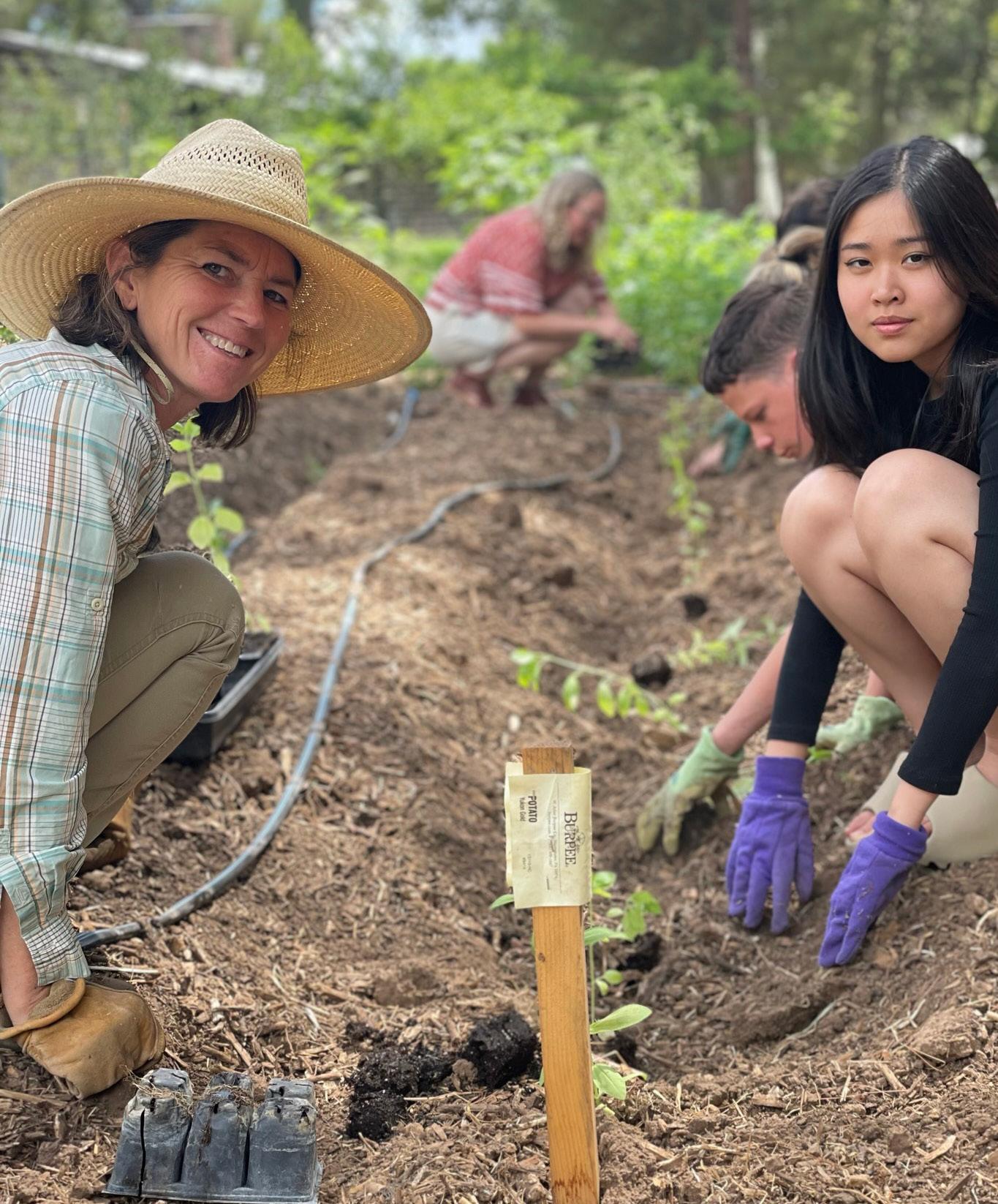
BY JENNIFER & JOHN BURKHART
If you find yourself searching for alternative remedies and therapies like we do, you might be getting bombarded with related ads on social media. Gotta love those algorithms! Sometimes though, it works in our favor and this time, it did. We saw an ad for a company that sells grounding mats and sheets and figured we needed to see what it's all about!

He Said: I had no idea this was even a thing. I thought I'd messed up and this was a punishment when Jen came home and told me we were going to be grounded to the bedroom. I did some research and found out that a grounding/earthing sheet is a special type of bed sheet that is supposed to help connect our bodies to the Earth's natural electrical charge. It is believed to help improve sleep and reduce inflammation by allowing electrons from the Earth’s surface to transfer to the body, neutralizing excess positive charge (free radicals). Basically, it helps you be more negative, which is good! I got a little concerned when the only setup instruction was to plug the bed sheet into the wall — nothing sketchy about that, right? Thankfully, it was only the ground socket that you plug it into. We slept on this every night for two months and I can truly tell you that I felt little to no difference in my sleep or stress levels. I think Jen stole all my electrons because it was plugged in on her side of the bed — thanks a lot, babe. While I can't vouch for the positives, I can tell you that there are literally no negatives to having this on your bed. So, we’ll keep it on the bed, because why not?
She Said: I think we can agree that we could all get outside more often, but when temps are volcanic or Arctic, no one wants to burn or freeze their bare feet off trying to “ground” outside. So, what could be easier than grounding while you're cozy in your bed, fast asleep? That's what these sheets do! It's a long, narrow organic cotton strip with silver fibers that fits any size bed and is in contact with about half your body (bare skin is best). Apparently, the benefits are similar to walking barefoot on the Earth's surface. The sheet's possible benefits include reducing chronic pain and inflammation, improving sleep quality, boosting mood and focus, and more. I couldn't wait to try it — I certainly have my share of aches and pains, probably inflammation, and often wake up at night while tossing and turning. We put it on the bed the same day it arrived and plugged it into the “ground” socket so we could get right to balancing our electrons. I kid you not, I noticed a difference the next day. I slept LIKE A LOG! No more waking up in the night, less tossing and turning (I think), and dreams galore! We've been sleeping on the sheet for two months and I still sleep very soundly through the night. That benefit alone was worth the purchase. Other than that, I don't think it's helped my aches or stiff joints yet, but I have hope!







The USA Fit Games Phoenix is a must-attend event for sports and fitness enthusiasts. This family-friendly expo offers over 500,000 square feet of activities, featuring an impressive lineup of exhibitors, live athletic events, and tournaments. Attendees can explore numerous exhibitor booths, enjoy samples of the latest fitness products, and witness thrilling live athletic competitions. The event also includes an exhilarating obstacle course and a fitness show. With ticket prices ranging from $10 to $25, the USA Fit Games Phoenix is expected to draw over 35,000 attendees, making it an unforgettable experience. WestWorld Scottsdale, 16601 N. Pima Rd., Scottsdale.

2, 9, 16, 23, 30
Start Fridays on a green note by volunteering at the Garden of Tomorrow. Every Friday morning offers a fulfilling and eco-friendly experience that will leave you refreshed and inspired. The Garden of Tomorrow is more than just a garden; it’s a vision of a sustainable and vibrant future. Nestled in the heart of the community, this lush oasis showcases what we can achieve when we come together to nurture the earth. Volunteering at the space not only enhances the garden's beauty but also promotes biodiversity and sustainable practices. Connect with nature, make new friends, and be part of a greener future. Garden of Tomorrow, 1823 E. Broadway Rd., Phoenix.
The Health and Wellness Expo at the Mesa Convention Center is a day of fun and education dedicated to promoting a healthy lifestyle. This event features the latest trends in fitness, nutrition, and mental well-being, with a wide range of exhibitors showcasing products and services, from fitness equipment to organic food. Attendees can join informative workshops and seminars led by experts, covering various topics like exercise routines, alternative medicine, and stress management techniques. Participate in interactive activities, try new fitness classes, sample healthy snacks, and engage in mindfulness exercises for a comprehensive wellness experience. Mesa Convention Center, 263 N. Center St., Mesa.
This event offers a chance to explore the latest in health and beauty, from skincare innovations to fitness trends. Attendees can engage with industry experts, sample new products, and participate in interactive workshops. It’s an ideal event for those looking to enhance their wellness routine and discover new beauty tips. Set aside the day to enjoy a fun and informative experience designed to inspire and pamper. Admission is free. Hilton Scottsdale Resort & Villas, 6333 N. Scottsdale Rd., Scottsdale.
Prescott Gem & Mineral Show
Over 60 vendors from the Southwest sell everything from slabs, cabochons, beads, finished jewelry, home accessories, equipment, and tools. You’ll find everything here, from a florescent booth, geode cutting, face painting, gold panning, demonstrations, and a spinning wheel to raffle drawings for valuable prizes. Many activities are available for both the youngsters and the young at heart. Tickets sold at the door (cash only). Parking is free at Findlay Toyota Center, 3201 N. Main St., Prescott Valley.
Arizona State Championship
Visit this chili fest for two days of chili cooking competition and public tasting with a First Responder Chili Challenge on Saturday, followed by the Best Restaurant Chili in Flagstaff on Sunday. Admission is free. Thorpe Park, 191 N. Thorpe Rd., Flagstaff.

This dog-friendly, walking beer tour offers 16 tastings from more than eight local breweries, bringing together dog lovers and beer enthusiasts. Stroll the charming streets and enjoy local brews while your pup socializes with other four-legged friends. Every dollar raised goes directly to supporting the incredible work of local animal rescue organizations and the Canyon Animal Care Foundation. Held at the County Courthouse Lawn at the corner of Birch & San Francisco Streets, Flagstaff.
Hosted by the Hopi Arts and Education Association (HAEA) with community partners, this unique festival showcases the talent of Hopi artists, featuring both contemporary and traditional artwork from Kachina carvers, silversmiths, and more. Established to support artisans during a major recession, the festival also aims to introduce Native culture and arts to the public. It promotes public education through art, traditional social dances, and cultural information to foster unity, happiness, and environmental stewardship among diverse communities. Continental Country Club Driving Range, Flagstaff.

Kick off Hummingbird Month in Sierra Vista, the Hummingbird Capital of the U.S.! The 33rd Southwest Wings Birding & Nature Summer Festival is a family-friendly event happening from Aug 1-3, 2024, and is now centrally located at The Mall at Sierra Vista. There will be fascinating presentations for kids and adults alike, along with exhibitors, vendors, and live animals. Admission is free. The Mall at Sierra Vista, 2200 El Mercado Loop, Sierra Vista.
This in-person health and wellness event offers a wide range of exhibits, workshops, and interactive activities. Attendees can discover the latest trends in fitness, nutrition, and mental health. Whether you are a health enthusiast or curious about living a healthier lifestyle, this expo is the perfect opportunity to learn, connect, and be inspired. Embark on a journey to a healthier you. Admission is free. Doubletree Hotel at Reid Park, 445 S. Alvernon Way, Tucson.




We are looking for experienced newspaper, magazine, and digital media Advertising Sales Representatives.
We are seeking candidates who have demonstrated skills in the following areas:
• Direct, in-person, B2B sales, especially in the advertising field
• The ideal candidate will have two to five years of sales experience
• The Ad Rep will report directly to the Publisher
Responsibilities include the following: direct, inperson B2B sales of advertising for print, website, and e-Marketing formats in addition to sponsorships for eco events and summit events, through a relationship-based approach, being articulate and professional in both communication and appearance.
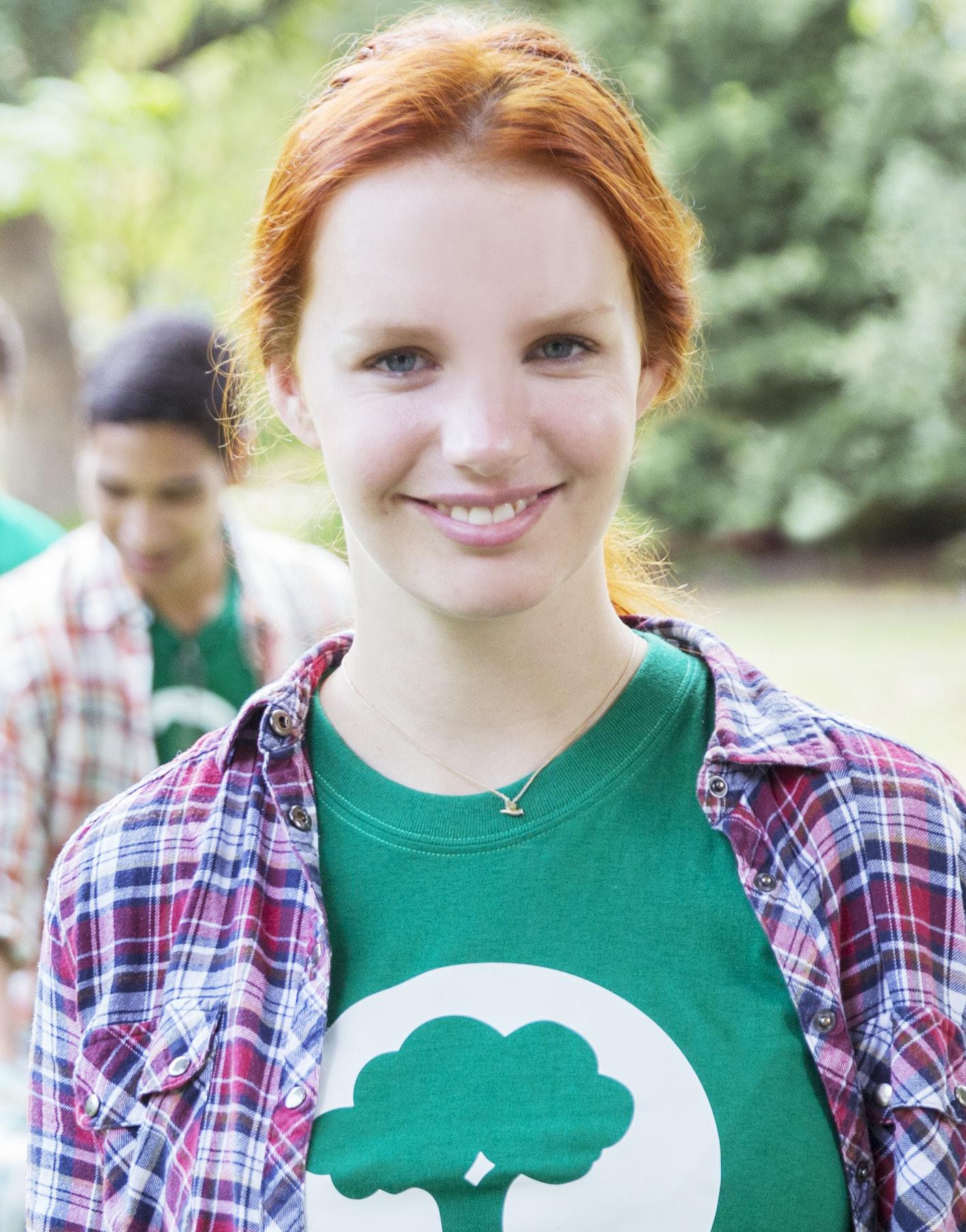


Are you still on track for retirement?
Investors have survived market swings and corrections before. But a twinge of uncertainty may have you wondering if you should get another opinion to help confirm your wealth is in the right place. That’s why we’ve made it as easy as we can to have a complimentary, face-to-face meeting with an advisor.
Ewing-Morales Group of Wells Fargo Advisors of Wells Fargo Advisors

18700 N. Hayden Road Suite 525
Scottsdale , AZ 85255
Direct: (480) 419-2016
mark.morales@wellsfargoadvisors.com
https://home.wellsfargoadvisors.com/mark.morales CA Insurance # 0D34255


Courtesy Automotive Group has an impressive selection of electric vehicles (EVs)! With an emphasis on cuttingedge technology and eco-friendly design, our EV selection showcases the latest advancements in automotive innovation. Courtesy specializes in EVs by Chevrolet, Nissan, Polestar, Jeep, Kia and Volvo. From sleek sedans to versatile SUVs, each vehicle offers not only zero-emission driving but also top-tier performance and advanced safety features.
Whether you’re a seasoned EV enthusiast or considering your first electric ride, Courtesy Automotive Group is dedicated to helping you find the perfect vehicle to fit your lifestyle!









